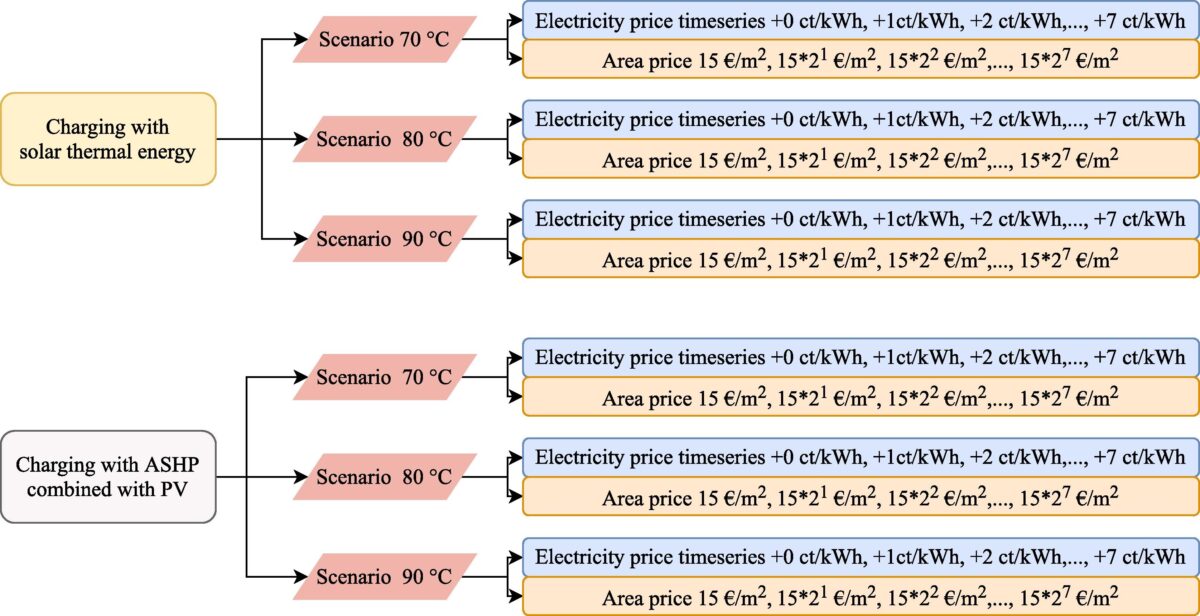Researchers at Germany's Fraunhofer Research Institution for Energy Infrastructures and Geothermal Systems (IEG) investigated how solar thermal-assisted heat pumps or air sourced heat pumps powered by ground-mounted photovoltaics (PV-ASHP) may be combined with pit thermal energy storage systems (PTESs) in a district heating network (DHN) under different scenarios and found that PV-ASHP systems may offer more advantages in densely populated areas.
Using open-source Python software, the group conducted a series of simulations on eastern Germany assuming different charging options for the PTESs. They also considered total system cost including Opex and Capex, as well as system designs and the network’s storage capacity during the operation. “The model separates the hydraulic and thermal calculation and builds up a multi-stage process to consider temperatures inside the network and the PTES,” it specified.
The scientists said their modeling was based on mixed integer linear programming (MILP), which is a mathematical approach to solving complex optimization tasks and identifying the potential trade-offs between conflicting objectives. It was reportedly able to design PTESs linked to a DHN while having volume and surfaces as variables to estimate heat losses accurately. “The main objective of this study is to develop a method capable of designing a complex supply structure and applying the method to a large-scale case study,” they added.
The proposed system design considers the use of several supply systems connected to DHN for a projected 38 GWh demand across 806 nodes in 2030. Three temperature, eight electricity, and eight area price scenarios were also taken into account. In total 90 scenarios were created. “The introduced tool can depict temperatures inside the DHN and the PTES,” the academics explained. “This crucial advantage makes it possible to decide when the storage can directly inject heat into the network, when a heat pump is needed, or how many compressor stages are required.”
The scientists also assumed the solar thermal-assisted heat pump to have a capacity of 10.95 MW and be powered by a 74,829 m2 solar thermal field. As for the PV-ASHP system, the HP capacity was 8.37 MW and the PV system covered a surface of 71,518 m2.
Popular content
Through their analysis, the group came to three main conclusions. First, a possible increase in electricity prices does not affect the viability of both schemes. Secondly, it found the PTESs are best suited for networks with temperatures exceeding 70 C. Lastly, they ascertained that more surfaces would be needed to deploy the solar thermal fields compared to ground-mounted PV plants. “The PTES volume ratio to solar thermal and PV fields is 2.54 m3/m2 and 2.9 m3/m2.,” they explained. “Both concepts occupy large amounts of area; therefore, they react sensitively to an increased area price.”
“The concept of PV with an ASHP is better suited for densely populated regions,” they concluded.
Their findings are available in the paper “Solar thermal vs. PV with a heat pump: A comparison of different charging technologies for seasonal storage systems in district heating networks,” published in Energy Conversion and Management X.
This content is protected by copyright and may not be reused. If you want to cooperate with us and would like to reuse some of our content, please contact: editors@pv-magazine.com.



By submitting this form you agree to pv magazine using your data for the purposes of publishing your comment.
Your personal data will only be disclosed or otherwise transmitted to third parties for the purposes of spam filtering or if this is necessary for technical maintenance of the website. Any other transfer to third parties will not take place unless this is justified on the basis of applicable data protection regulations or if pv magazine is legally obliged to do so.
You may revoke this consent at any time with effect for the future, in which case your personal data will be deleted immediately. Otherwise, your data will be deleted if pv magazine has processed your request or the purpose of data storage is fulfilled.
Further information on data privacy can be found in our Data Protection Policy.